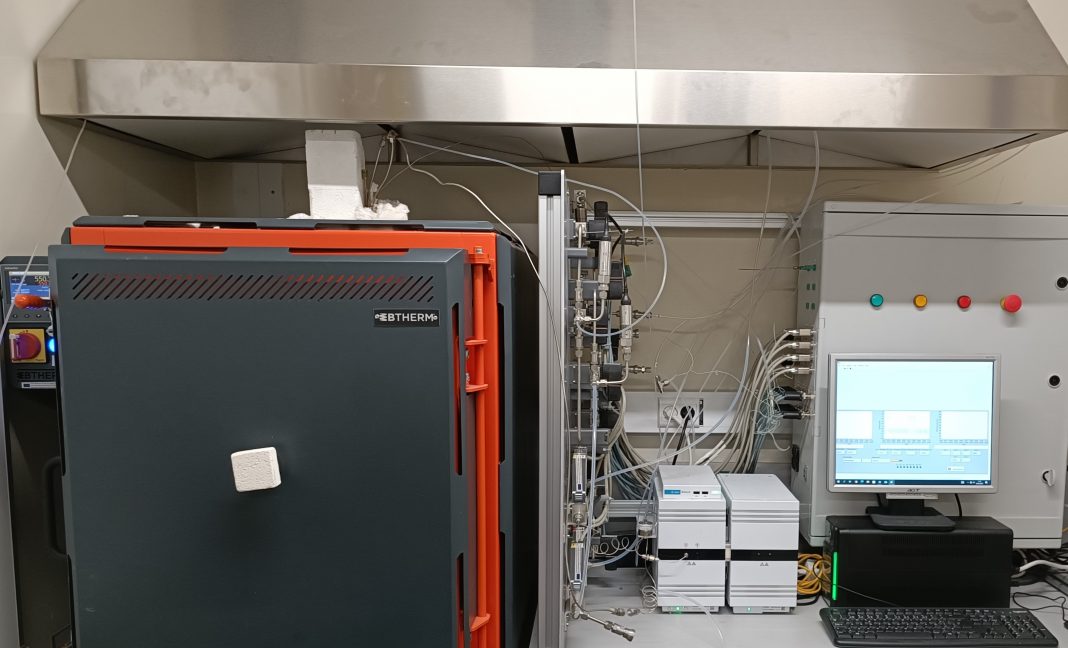Professor Adélio Mendes from the University of Porto – Faculty of Engineering coordinates the Horizon-funded project “112CO2 – Low temperature catalytic methane decomposition for COx-free hydrogen production”
A game-changer low temperature catalytic methane decomposition process proved already >2500 h of continuous operation at 550°C with a constant catalyst productivity of 0.64 gH2/gCat/h. But the experiment is going on, aiming at reaching over 6000 h of fully stable operation, by September 2023; at that moment the technology will reach the stability milestone for becoming a commercial solution.
The methane decomposition membrane reactor operates between 550°C and 700°C producing pure hydrogen, according to the reaction equation:
CH4 ⇌ C + 2H2 ΔH° = 75.3 kJ/mol
The carbon by-product is >90 % graphitic, which is a quite valorized carbon and especially suitable for making electric conductive carbon paints, electrodes for electrochemical devices, bipolar plates for PEMFC (polymer electrolyte membrane fuel cell) and redox flow batteries, anodes of sodium-ion batteries, among a variety of other high-value applications. But these carbon particles of ca. 100 μm can also find use for making concrete, asphalt for streets and fertilizers for soil. However, the most amazing thing is that this carbon by-product can be tuned for its properties modifying the catalyst and changing the operating conditions, getting the best of the two products from the methane decomposition reaction.
Removing CO2 from the atmosphere
If the methane used comes from a renewable source such as biogas, this reaction not only would remove CO2 from the atmosphere, but it also would allow to produce graphitic renewable carbon and bright hydrogen – the proposed color-code for this hydrogen, produced from a renewable source, with negative CO2 emissions and low cost. Also, this bright hydrogen can be made to react with CO2 from biogas to produce bright methanol, with an estimated cost of ca. 300 €/ton¥, which compares quite nicely with the present price from Methanex – 478 €/ton, and if the emitted CO2 is included in the methanol price, with the final value of 611 €/ton.
Competitive landscape
There are several processes to accomplish the methane decomposition, also known as methane cracking, originating different process names. The most known methane decomposition process is the methane pyrolysis, which is being developed by BASF. This process runs at temperatures of ca. 1400 °C and has the advantage of almost complete methane conversion but requires too high temperatures, which makes the process unsafe and expensive. The thermochemical process by Hazer Group operates at ca. 900 °C and uses an iron-based catalyst. This process reaches high methane conversions but uses a low temperature PSA (pressure swing adsorption) hydrogen purification system for recycling the unreacted methane.
The plasma-based process, originally developed by Kvaerner and now commercialized by Monolith, uses a plasma reactor for running this reaction. However, this process originates carbon fouling requiring an intermittent operation for carbon removal. The molten metal reactor by KIT or molten salt reactor from CZero, running between 750 °C and 1000 °C, are unsafe and the produced carbon drags out molten baths and catalysts, which are significant drawbacks.
Catalytic methane decomposition process has never been demonstrated before
Though the promising advantages of fast reaction kinetics, high power density and lower costs, the low-temperature catalytic methane decomposition process has never been tried before due to several paramount technical challenges. The EU Project 112CO2 is provenly overcoming all these challenges making turquoise/bright hydrogen easily available also for mobility applications, in compact and safe devices. But how is it possible that a nickel-based catalyst stays active over this much time when the literature average longest time-on- stream is ca. 60 h? Project 112CO2 developed a unique cyclic regeneration strategy, which combined with a disruptive reactor design and a nickel-based supported catalyst, makes the methane decomposition to be fully stable for thousands of hours. The methane decomposition reaction in these conditions is 100 % selective, allowing the hydrogenation of the catalyst/coke interface, making the produced carbon to detach periodically from the catalyst surface; this hydrogenation process uses ca. 6 % of the produced hydrogen. This reaction is equilibrium limited, where at 600 °C and 1 bar the equilibrium conversion is ca. 60 %. A set of inorganic non-metal membranes, displaying an ideal selectivity of ca. 2500, is used to permeate hydrogen allowing the remaining methane to react for producing more hydrogen – so the name of membrane reactor.
The 112CO2 research team and ongoing research
Right now, the 112CO2 research team is continuing to improve the catalyst aiming at much longer production step times before regeneration – less number of regeneration cycles – and displaying higher catalytic activities. Also, the reactor catalyst load should be increased to reach even higher power densities – target power density of 10 kW/L, while the hydrogen permeable membranes are being improved to display higher permeabilities. A fully integrated lab low-temperature catalytic methane decomposition membrane reactor is expected to be demonstrated by the end of 2023, while a pilot reactor is expected to be demonstrated by the end of 2024.
¥ Main assumptions: price of the biomethane is 55 €/MWh, benefits from removing atmospheric CO2 is 97 €/ton (same as the allowances price) and the graphitic carbon worth 400 €/ton.

This work is licensed under Creative Commons Attribution-NonCommercial-NoDerivatives 4.0 International.


